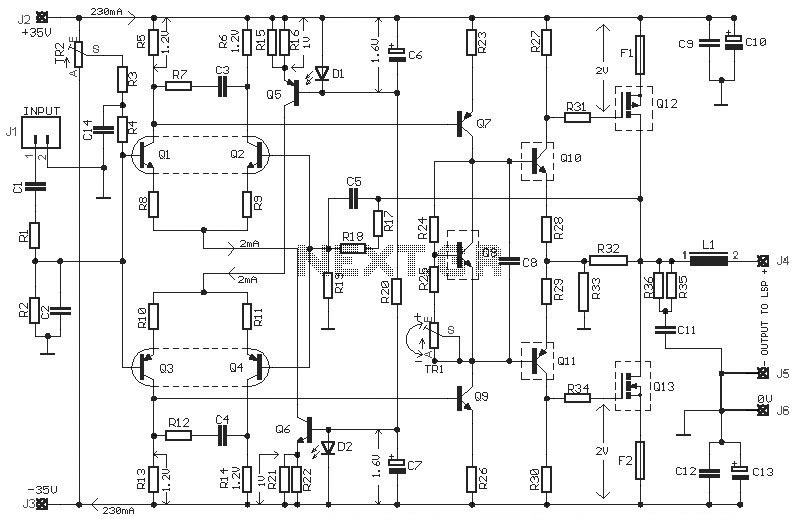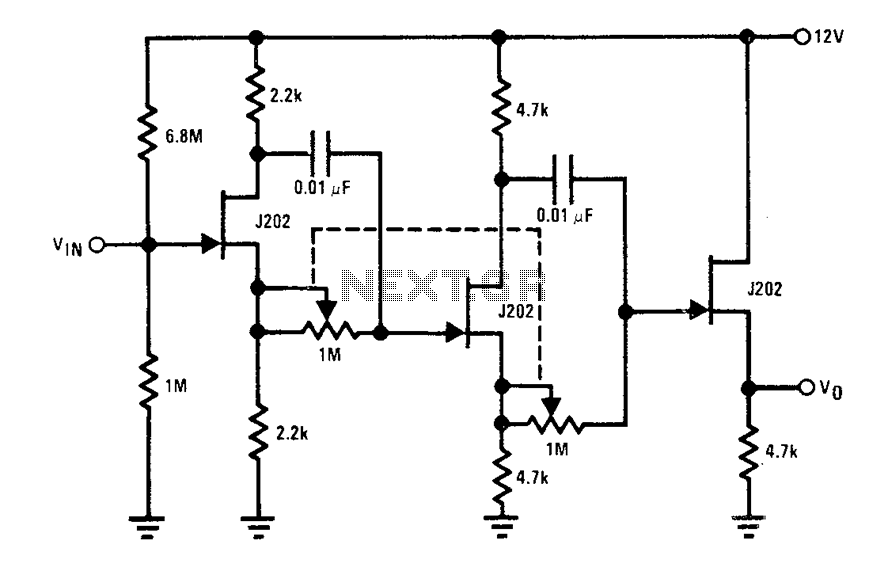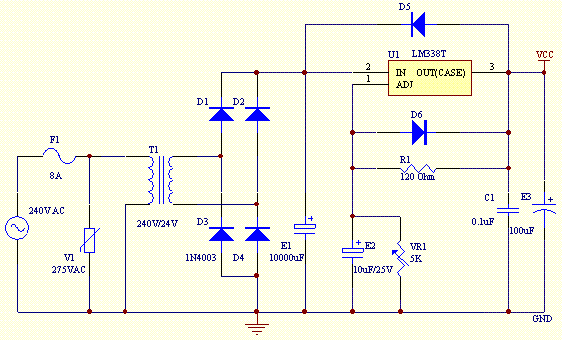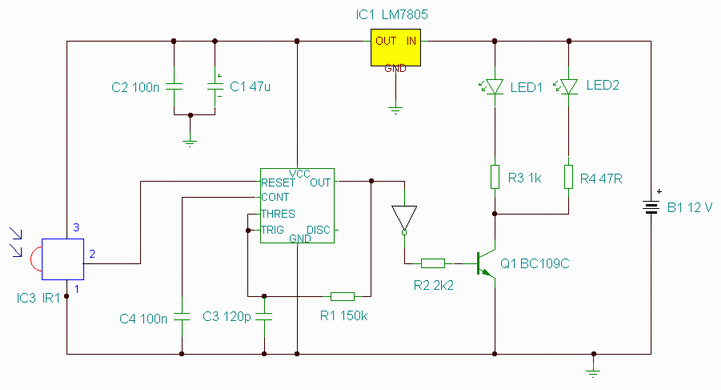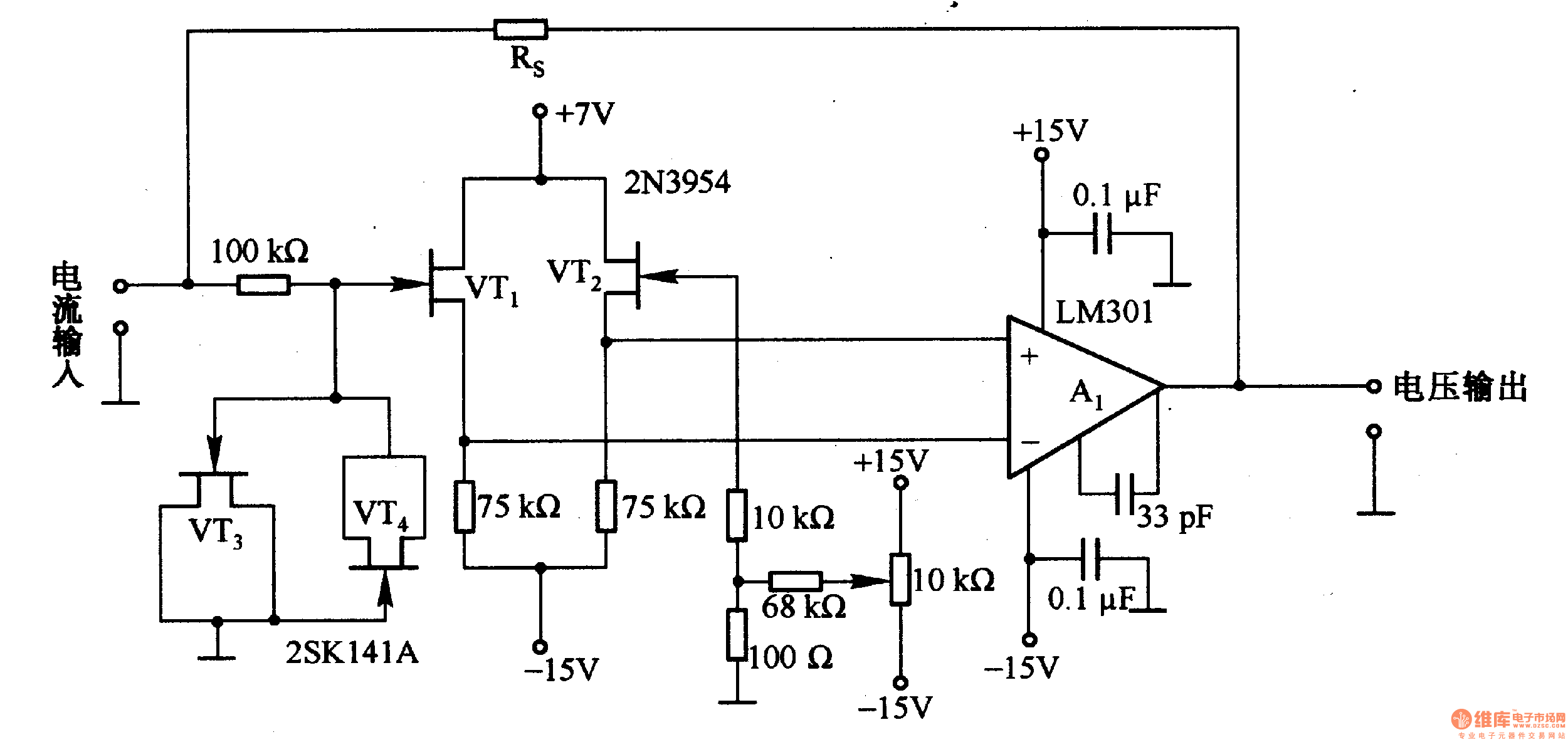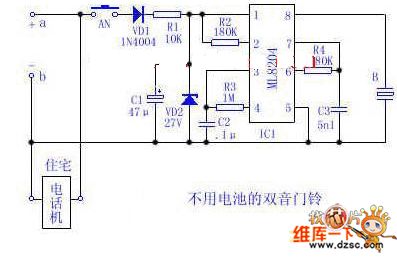
High-Voltage Regulator With Short Circuit Protection
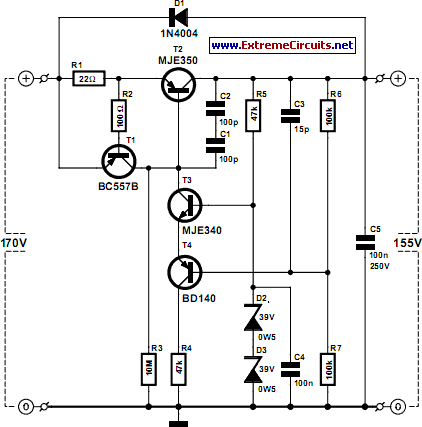
There are numerous circuits designed for low voltage regulators. However, for higher voltages, such as those required for valve circuits, the approach differs. This is the reason for the design of a simple regulator capable of handling these voltages. The circuit is particularly suitable for integration with the quad power supply for the hybrid amplifier discussed elsewhere in this issue. The regulator consists of three main transistors, with a fourth transistor added for current limiting. This circuit functions as a positive series regulator, employing a PNP transistor (T2) to minimize the voltage drop. The operation is straightforward: if the output voltage decreases, T4 lowers the emitter of T3, which drives T2 more aggressively, resulting in an increase in output voltage. R4 limits the base current of T2, while C1 and C2 are included to enhance circuit stability. These capacitors are connected in series to prevent excessive voltage across each during switch-on or short-circuit conditions; capacitors rated for at least 100 V should be used for C1-C3. D1 safeguards T2 from negative voltages that may arise during input short circuits or when large capacitors are connected to the output. Two 39 V zener diodes are connected in series to provide the reference voltage of 78 V to the base of T3. Since R6 equals R7, the output voltage is approximately double, around 155 V. T4 serves as a buffer for the potential divider formed by R6 and R7, allowing the use of higher resistor values without affecting the voltage due to the base current of T2, which is comparable to the emitter current of T3. Although this circuit lacks temperature compensation, it is adequate for its intended purpose. The current limiting section, constructed around T1, is quite simple. When the output current exceeds 30 mA, the voltage across R1 activates T1, which subsequently limits the base-emitter voltage of T2. R2 protects T1 from rapid peak voltages across R1, while R3 is necessary to initiate the regulator, as it allows T2 to conduct slightly, enabling the regulator to reach its intended state. Under normal operation, with a 15 V drop across T2 and a current of approximately 30 mA, additional cooling for T2 is unnecessary, although the junction temperature can reach 70 °C, posing a burn risk. The regulator can supply more current with lower input voltages, as this is governed by the Safe Operating Area (SOAR) of T2. During a short circuit with an input voltage of 140 V, the current reaches about 30 mA, necessitating a heatsink for T2 with a thermal resistance of at least 10 K/W under these conditions. To increase the output voltage, a larger value for R6 should be used. For a higher reference voltage, T4 can be replaced with an MJE350. If only a few milli-amps are required, T4 and R4 can be omitted, allowing the potential divider (R6/R7) to connect directly to the emitter of T3. The circuit achieves ripple suppression of approximately 50 dB, with a quiescent current of 2.5 mA and a dropout voltage of only 1.5 V for small currents.
This circuit design is a robust solution for high voltage regulation, effectively managing the challenges associated with higher supply voltages. The use of a PNP transistor (T2) as the main regulating element ensures a low voltage drop, enhancing efficiency. The integration of a current limiting feature using T1 provides an essential safeguard against overcurrent situations, which is critical in maintaining circuit integrity and protecting components. The careful selection of resistor values in the potential divider (R6/R7) allows for precise voltage regulation, while the series connection of capacitors (C1 and C2) contributes to stability during transient conditions. The inclusion of zener diodes for reference voltage ensures consistent operation under varying load conditions. Overall, this design emphasizes reliability and simplicity, making it suitable for applications requiring stable high voltage regulation.There are many circuits for low voltage regulators. For higher voltages, such as supplies for valve circuits, the situation is different. That`s why we decided to design this simple regulator that can cope with these voltages. This circuit is obviously well suited for use in combination with the quad power supply for the hybrid amp, published else where in this issue. The actual regulator consists of just three transistors. A fourth has been added for the current limiting function. The circuit is a positive series regulator, using a pnp transistor (T2) to keep the voltage drop as low as possible. The operation of the circuit is very straightforward. When the output voltage drops, T4 pulls the emitter of T3 lower. This drives T2 harder, which causes the output voltage to rise again. R4 restricts the base current of T2. C1 and C2 have been added to improve the stability of the circuit. These are connected in series so that the voltage across each capacitor at switch-on or during a short circuit doesn`t become too large.
You should use capacitors rated for at least 100 V for C1-C3. D1 protects T2 against negative voltages that may occur when the input is short-circuited or when large capacitors are connected to the output. We use two zener diodes of 39 V connected in series for the reference voltage, giving 78 V to the base of T3.
Because R6 is equal to R7 the output voltage will be twice as large, which is about 155 V. T4 acts as a buffer for potential divider R6/R7, which means we can use higher values for these resistors and that the voltage is not affected by the base current of T2 (this current is about the same as the emitter current of T3). This is obviously not a temperature compensated circuit, but for this purpose it is good enough. The current limiting section built around T1 couldn`t be simpler. When the output current rises above 30 mA the voltage across R1 causes T1 to conduct. T1 then limits the base-emitter voltage of T2. R2 is required to protect T1 against extremely fast peak voltages across R1. R3 is needed to start the regulator. Without R3 there wouldn`t be a voltage at the output and hence there wouldn`t be a base current in T2.
R3 lets T2 conduct a little bit, which is sufficient for the regulator to reach its intended state. During normal operation with a voltage drop of 15 V across T2 and a current of about 30 mA there is no need for extra cooling of T2. The junction temperature is then 70 °C, which means you can burn your fingers if you`re not careful! The lower the input voltage is, the more current can be supplied by this regulator. This current is determined by the SOAR (Safe Operation ARea) of T2. During a short circuit and an input voltage of 140 V the current is about 30 mA and T2 certainly requires a heatsink of at least 10 K/W in those conditions.
To increase the output voltage you should use a larger value for R6. If you want to use a higher reference voltage, you should replace T4 with a MJE350. If you only ever need to draw a few milli-amps there is no need to include T4 and R4. The potential divider (R6/R7) can then be connected directly to the emitter of T3. The ripple suppression of the circuit is about 50 dB. The quiescent current is 2. 5 mA and for small currents the dropout voltage is only 1. 5 V. 🔗 External reference
This circuit design is a robust solution for high voltage regulation, effectively managing the challenges associated with higher supply voltages. The use of a PNP transistor (T2) as the main regulating element ensures a low voltage drop, enhancing efficiency. The integration of a current limiting feature using T1 provides an essential safeguard against overcurrent situations, which is critical in maintaining circuit integrity and protecting components. The careful selection of resistor values in the potential divider (R6/R7) allows for precise voltage regulation, while the series connection of capacitors (C1 and C2) contributes to stability during transient conditions. The inclusion of zener diodes for reference voltage ensures consistent operation under varying load conditions. Overall, this design emphasizes reliability and simplicity, making it suitable for applications requiring stable high voltage regulation.There are many circuits for low voltage regulators. For higher voltages, such as supplies for valve circuits, the situation is different. That`s why we decided to design this simple regulator that can cope with these voltages. This circuit is obviously well suited for use in combination with the quad power supply for the hybrid amp, published else where in this issue. The actual regulator consists of just three transistors. A fourth has been added for the current limiting function. The circuit is a positive series regulator, using a pnp transistor (T2) to keep the voltage drop as low as possible. The operation of the circuit is very straightforward. When the output voltage drops, T4 pulls the emitter of T3 lower. This drives T2 harder, which causes the output voltage to rise again. R4 restricts the base current of T2. C1 and C2 have been added to improve the stability of the circuit. These are connected in series so that the voltage across each capacitor at switch-on or during a short circuit doesn`t become too large.
You should use capacitors rated for at least 100 V for C1-C3. D1 protects T2 against negative voltages that may occur when the input is short-circuited or when large capacitors are connected to the output. We use two zener diodes of 39 V connected in series for the reference voltage, giving 78 V to the base of T3.
Because R6 is equal to R7 the output voltage will be twice as large, which is about 155 V. T4 acts as a buffer for potential divider R6/R7, which means we can use higher values for these resistors and that the voltage is not affected by the base current of T2 (this current is about the same as the emitter current of T3). This is obviously not a temperature compensated circuit, but for this purpose it is good enough. The current limiting section built around T1 couldn`t be simpler. When the output current rises above 30 mA the voltage across R1 causes T1 to conduct. T1 then limits the base-emitter voltage of T2. R2 is required to protect T1 against extremely fast peak voltages across R1. R3 is needed to start the regulator. Without R3 there wouldn`t be a voltage at the output and hence there wouldn`t be a base current in T2.
R3 lets T2 conduct a little bit, which is sufficient for the regulator to reach its intended state. During normal operation with a voltage drop of 15 V across T2 and a current of about 30 mA there is no need for extra cooling of T2. The junction temperature is then 70 °C, which means you can burn your fingers if you`re not careful! The lower the input voltage is, the more current can be supplied by this regulator. This current is determined by the SOAR (Safe Operation ARea) of T2. During a short circuit and an input voltage of 140 V the current is about 30 mA and T2 certainly requires a heatsink of at least 10 K/W in those conditions.
To increase the output voltage you should use a larger value for R6. If you want to use a higher reference voltage, you should replace T4 with a MJE350. If you only ever need to draw a few milli-amps there is no need to include T4 and R4. The potential divider (R6/R7) can then be connected directly to the emitter of T3. The ripple suppression of the circuit is about 50 dB. The quiescent current is 2. 5 mA and for small currents the dropout voltage is only 1. 5 V. 🔗 External reference
